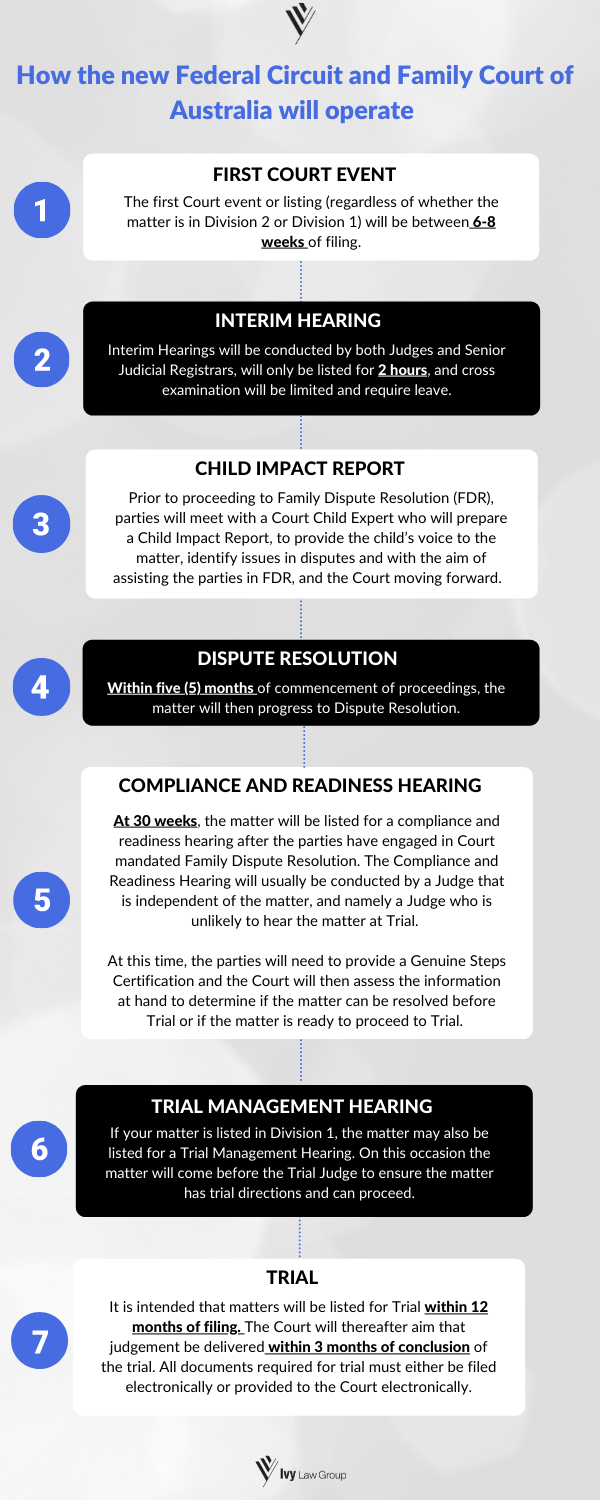Why did the two Courts merge?
The overarching purpose of the new family Court system is to “facilitate the just resolution of disputes according to law and as quickly, inexpensively and efficiently as possible.”
The Court’s aim is to resolve 90% of matters within 12 months, and which they intend to achieve by:
- focusing on dispute resolution (external and internal, where safe to do so).
- Implementing a new pre-action requirement for both parties in a family law matter, whereby a Genuine Steps Certificate must be filed to demonstrate that attempts have been made to resolve the matter prior to filing.
- Having separate lists for matters, and by way of example individual lists that deal exclusively with:
- Property; and
- Contravention Applications – now to be triaged within 14 days.
- Having cost implications for parties and /or their lawyers who don’t conduct matters in a manner consistent with the Court’s overarching purpose.
- Having the first court event and the interim hearing conducted on the same day and where there are matters of urgency.
- Continuing to have electronic hearings where it would assist the parties.
- Having matters that are listed for trial but not reached, heard electronically by Judges who are available in other registries.
- Allocating matters to a Fast-Track Hearing list where there will only be short form Judgements issued, and those matters will be determined on:
- Written submissions of no more than 10 pages.
- Filed Affidavit evidence only.
- Expert reports and material provided to the Court.
- The appointment of new court staff and including 10 additional judges (2 appointed to Division 1 and 8 appointed in Division 2), Senior Judicial Registrars, Court Child Experts, and 5 new Indigenous List liaison officers.
How will the new Court operate?
The new Federal Circuit and Family Court of Australia (FCFCOA) will have two divisions:
- Division 1: which will hear Family Law matters only.
- Division 2: which will hear Family and general Federal Law matters.
All matters coming to the FCFCOA will enter the Court through Division 2. A National Assessment Team may then consider the matters filed, and for complex property matters, matters of extreme risk of harm, or otherwise matters whereby Division 1 of the Court holds exclusive jurisdiction i.e., Hague Convention matters, these will be transferred directly to Division 1. Otherwise, the balance of matters, and likely to be 90% of matters coming before the Court would remain in Division 2.
What will happen with existing matters before the court?
All existing matters will be subject to the new rules and practice directions.
Matters listed for Trial
Any matters already listed for trial, and prior to 1 September 2021, are likely to proceed as listed. However, where they do not have a further return date before they reach Trial, a further return date is likely to be allocated and to ensure there has been compliance with trial directions and the matter is ready to proceed to Trial, or alternatively to make further trial directions as necessary.
There is a possibility that further trial dates will become available and matters already listed for trial could be brought forward and to fill in gaps in the Court’s timetable, but also to ensure these matters are resolved as a matter of priority.
Contravention Applications prior to 1 September 2021
Contravention applications already underway prior to the Court merger (applications relating to breaches of Court Orders) will be fast tracked to the Contravention List as of 1 September 2021, and thereafter triaged within 14 days, in line with the new process.
An overview of the new Court process
Under the new Court system, parties in a family law matter should not file proceedings until they have attended to and exhausted all the pre-action requirements, which include:
- Family Dispute Resolution.
- Exchanging a notice of intention to commence property claim and exploring options for settlement.
- Complying with the duty of disclosure.
- Preparing a Genuine Steps Certificate outlining all the attempts made to settle the dispute.
Family law practitioners are also required to give clients a notice that sets out the genuine attempts needed or taken to resolve the dispute, costs involved and the length of the matter.
Here at Ivy Law Group, our Sydney family law team have familiarised themselves with the new Court and how it will operate going forward. If you have any concerns, queries or wish to obtain legal advice about a family law matter, give us a call on 02 9262 4003 or submit an online enquiry.

What if a decision needs to be appealed?
In the new Federal Circuit and Family Court of Australia, all Division 1 judges will be able to hear appeal matters.
For decisions or Interim-Judgements made at Interim Hearings, there will be:
- a right of review from a Registrar’s finding and heard before a single judge of that Division;
- an appeal to a single Division 1 judge when the decision is made by a Division 2 Judge.
- an appeal to a Full Court of Judges (three) from Division 1 when the decision appealed is that of a Division 1 Judge.
If you are unsure of what these new changes mean or you wish to appeal a decision, please get in contact with our Sydney family lawyers for assistance on 02 9262 4003 or submit an online enquiry.
Rules, Regulations and Legislation governing the new Court
The new Federal Circuit and Family Court of Australia will be governed by the following legislation:
- Federal Circuit and Family Court of Australia Act 2021
- Family Law Act 1975
The new rules of the FCFCOA are as follows:
- the Federal Circuit and Family Court of Australia (Family Law) Rules 2021;
- the Federal Circuit and Family Court of Australia (Division 2) (Family Law) Rules 2021;
The new Practice directions of the Court will be divided into the following areas:
- Central Practice Direction – Family Law Case Management
- Family Law Practice Direction – Appeals
- Family Law Practice Direction – Arbitration
- Family Law Practice Direction – Bankruptcy Act proceedings
- Family Law Practice Direction – Corporations Act proceedings
- Family Law Practice Direction – Divorce proceedings
- Family Law Practice Direction – Financial proceedings
- Family Law Practice Direction – Lighthouse Project and Evatt List
- Family Law Practice Direction – Medical procedure proceedings
- Family Law Practice Direction – National Contravention List
- Family Law Practice Direction – National COVID-19 List
- Family Law Practice Direction – Nullity and validity of marriage proceedings
- Family Law Practice Direction – Parenting proceedings
- Family Law Practice Direction – Passport proceedings
- Family Law Practice Direction – Priority Property Pools under $500,000
- Family Law Practice Direction – Surrogacy proceedings
- Family Law Practice Direction – Trans-Tasman Proceedings Act proceedings
- FCFCOA Practice Direction – Transitional Arrangements
Need assistance on a family law matter or help understanding the changes?
If you have a new family law matter you would like to discuss, or concerns about an existing matter and how it will be impacted by the changes, our experienced Sydney Sydney family lawyers are here to assist.
Please don’t hesitate to get in touch with Ivy Law Group us on (02) 9262 4003 or submit an online enquiry here.
The content of this article is intended as a general guide to the subject matter. For specific legal advice about your individual circumstances, please contact our experienced lawyers.
Pamela is a member of Ivy Law Group’s prominent Family Law division. She specialises in parenting, property and divorce matters.
Pamela is a strong advocate for her clients and gains great satisfaction in helping them navigate through a difficult time in their lives and achieving an outcome that resolves their dispute to the highest standard.




